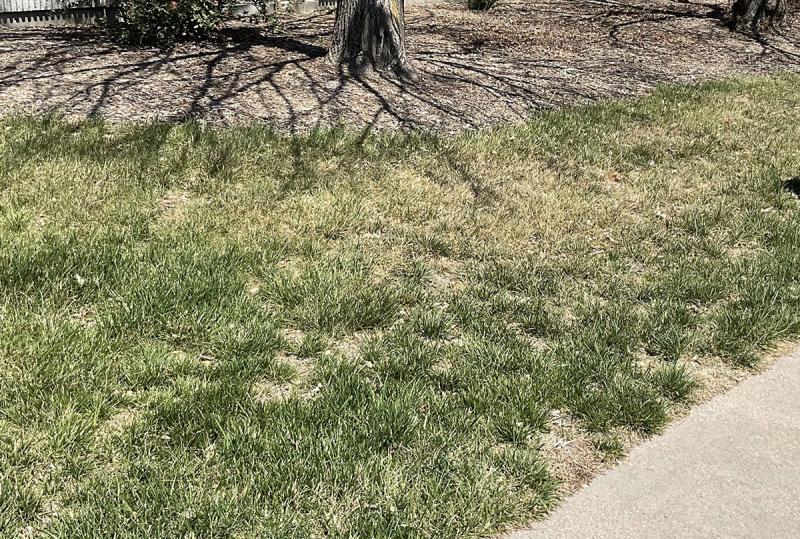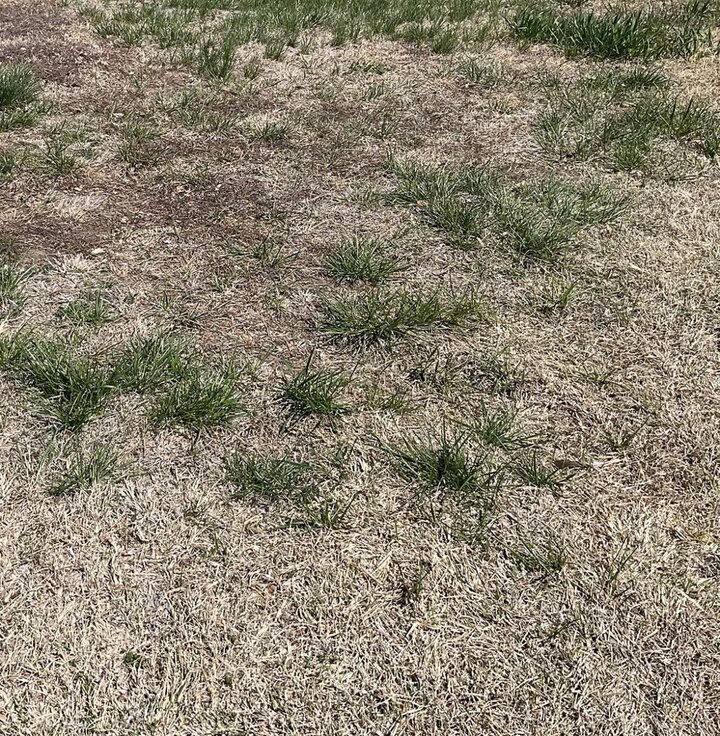Sarah Browning, Nebraska Extension Educator

Moderate drought damage in turf resulting in small bare patches and thinning. Image by Sarah Browning, Nebraska Extension.
What happened to our April showers? The Lincoln area received only 0.59 inches of rain – measured at the Lincoln Airport - instead of our normal 2.69 inches for April. May is not looking good either – only 0.49 inches so far, compared to our normal 4.91 inches. I cringe to think what the rest of summer bring!
We ended 2022 with a serious rainfall deficient – 11.90 inches below normal, measured from January 2021 through December 2022. In 2023, that deficit has gotten even larger. We’re now 15.22 inches below normal (January 2021 through April 2023).
With this serious lack of water in the soil, it should come as no surprise our landscapes are suffering.

Lawn Problems
Last fall many lawns were looking rough. Large sections of turf had turned brown - but we have seen that often enough in the past and it’s only gone dormant, right? In this case, the answer is no. Many lawns got so dry grass crowns were dying.
As lawns began growing this spring, large dead patches and/or severe thinning due to drought was common. But why did only certain patches of grass die?
There are several possible reasons for this.
- Some areas are more exposed to hot afternoon sun, such as the south side of a tree or an area receiving reflected heat and sun from a hard surface.
- Some areas may have compacted soil which reduces water’s ability to percolate in the soil and replenish soil water reserves. In this instance, even when it did rain a lower amount of rainfall actually moved down into the soil, while a higher percentage was lost to runoff.
- It’s common over time for older lawns to become a patchwork mixture of grass species. They may contain a mixture of Kentucky bluegrass, turf-type tall fescue, perennial ryegrass and sometimes the fine fescues (red, chewings and sheep fescue). There can also be a mixture of older and newer cultivars with varying levels of resistance to stress. Normally short-lived species like perennial ryegrass are particularly prone to death-by-drought.

Recovery
The only remedy now is to reseed or resod damaged areas. Unfortunately, spring seeding should be completed between April 25 and May 15th. If seeding is done later in summer, the overall success rate will be low as heat, drought and weed competition make grass establishment harder.
The ideal time for grass seeding is fall, August 15ththrough September 15th. If you decide to wait, keep the remaining grass and weeds mowed, and prepare for fall seeding by heavily aerating the damaged areas. If you want to patch some areas with sod, that can be done anytime throughout summer.
Deep infrequent irrigation.Watering often, 3+ irrigations per week, but more shallowly, decreases rooting depth and reduces overall turf health, thus creating a lawn less able to tolerate heat/drought stress.
What does deep and infrequent mean? Apply enough water at each irrigation to reach the bottom of turf roots – 3 to 6 inches. When wait until the soil dries to irrigate again. An easy method to figure out how deeply your irrigation water has penetrated the soil is by sticking a long-bladed screwdriver or other metal probe into the ground after irrigation. The probe should move easily through moistened soil, but will resist when it encounters dry soil.
Remove the probe from the soil and measure the depth of soil moistened. When pulled out of the ground, the probe should be moist- not dry or soggy wet. If your irrigation system is not applying enough water to reach the bottom of your plant roots, then adjust the zone run times or use the soak & cycle method.
Soak & Cycle - Start by running the irrigation system as usual. Afterwards, measure how deeply the moisture has gone into the soil. Then if additional moisture penetration is needed, run the irrigation zones again in the same day. This will allow water to penetrate even deeper in the soil.
The screwdriver technique can also be used to determine when watering is needed. After watering, wait until the soil gets drier and the probe is harder to push, then it’s time to water again.
Sharpen your mower blade. Don’t make the situation worse on your drought-stressed lawn by mowing with a dull blade. The jagged rips and tears cause by a dull blade increase overall water use. The jagged tips will die soon after mowing, creating an even worse brown coloration to the lawn, often following the tracks of your mowing pattern.
Raise your mowing height. If you’re not there already, raise your mowing height to 3-3.5 inches. Taller leaf blades help shade the soil surface, keeping plant crowns cooler. Plus, root depth is directly related to leaf height- meaning the taller your grass leaf blades, the deeper your grass roots will be.
Be careful with herbicide applications. Even if the product is labeled for use on turf and selectively controls only broadleaf weeds, application to a turf under drought stress can lead to damage. If weed control is necessary, make sure the lawn is well watered before making the application.
Limit fertilization.Finally, don’t try to fertilizer your lawn out of drought stress. Nitrogen applications on a drought stressed lawn can result in leaf burn. Plus, nitrogen encourages leaf growth at the expense of root growth. During drought, anything you can do to increase the depth of your lawn roots will increase the health of your turf.
Next week we’ll take a look at current drought damage found in many landscape shrubs and trees – there’s way too much of it this year!
Images
- Severe drought damage in turf resulting in widespread grass death. Image by Sarah Browning, Nebraska Extension.
- Turf drought damage on the south side of a tree where the grass receives little to no shade during the day. Client image used with permission.
Search Our Archive
Associated Video
Turf Winterkill
UNL Extension Turfgrass Specialist Bill Kreuser talks about how turf can be damaged by harsh winter conditions